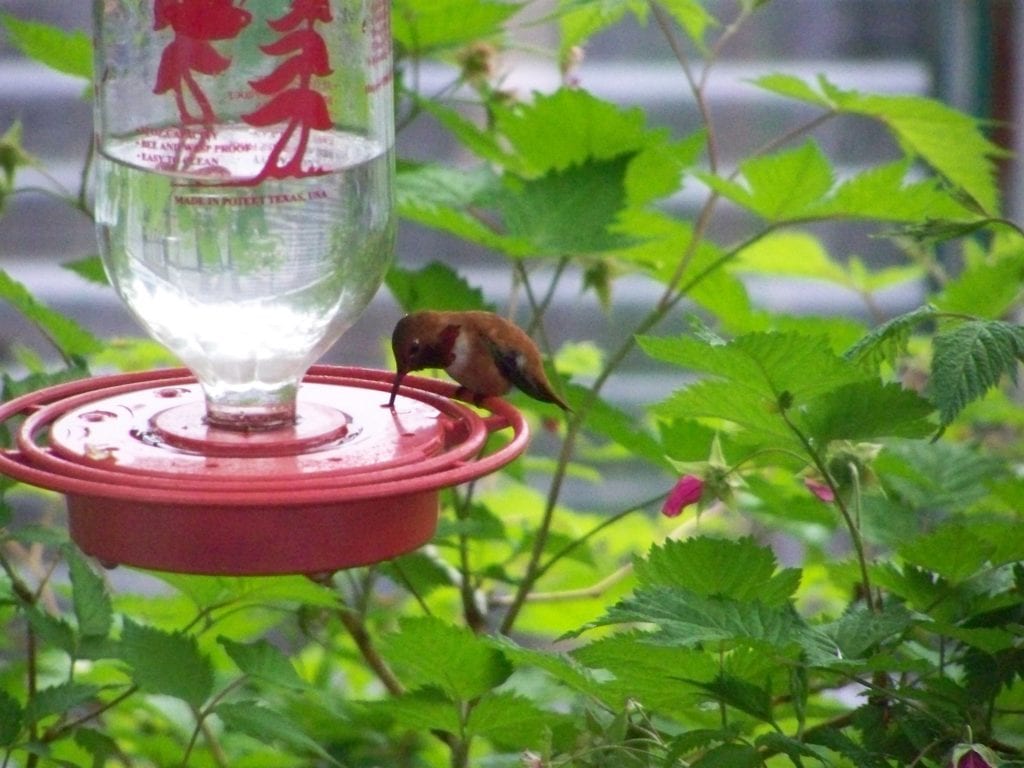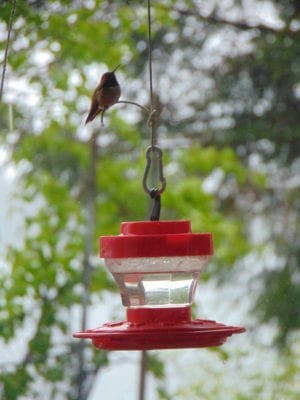
By Kate McLaughlin
For The Cordova Times
It’s the first of May. Rain is washing the snowpack off the berry bushes and hummingbirds are moving up the Pacific flyway, heading for the Copper River Delta and Prince William Sound. There’s a sweet tang in the air from the budding willows and alders, an important spring resource for the rufous hummingbird.
The average first hummingbird sighting for Prince William Sound is April 22, so I hang my feeders about a week before. Hummingbirds remember every single flower patch and feeder that they visit, so if you maintain your feeders properly you can enjoy these acrobatic jewels every season.
No need for fancy mixes, dyes or attractants, some of which can actually harm the birds. Just cane sugar and clean, fresh water is all you need.
Sugar to water ratio: one part sugar to four parts water.
Dissolve the sugar in hot water and let cool to room temperature before filling feeders. Refrigerate the unused portion. Change the syrup at least once a week, or if it looks dirty.
Do not use honey, sugar substitutes, or increase the recommended sugar amount. Hummingbirds cannot process other types of sugar, and too high of a sugar ratio can harm hummingbirds’ liver and kidneys.
Keep feeders clean! Mold and contamination can cause a host of diseases and illnesses.
To clean, disassemble your feeder and soak the parts in warm soapy water. Scrub with a bottle brush, then rinse well. Let it dry completely before refilling with syrup. For very dirty feeders, soak in hot water and Oxyclean. Scrub and rinse thoroughly in clean water before refilling. A good rule of thumb is: don’t let the birds drink what you wouldn’t drink yourself!
Now that you have your feeders clean and syrup made, where should they be hung?

Pick a sheltered spot out of the wind and close to trees or bushes where the birds can take cover. If near a window, check for a reflective glare that might cause a bird to crash into it. A decal placed on the window to break up the reflection will usually solve that problem.
Being in bear country is also a consideration in where, how, and how many feeders are hung. Persistent black bears cause havoc. Once they get a taste of that sugar syrup, they will come back for more. Utilizing a high porch overhang, feeders strung on high wires between trees, or a couple of noisy dogs may be all you need to keep the bruins from raiding the tasty treats.
Once the birds have found your feeder, they will remember its location and will return each year to that exact spot. The males can be very greedy and may guard a feeder, chasing all others away. To solve this, hang two or three other feeders 10 to 20 feet away from the one being guarded, leaving the cluster for the females and young.
Make your yard attractive to hummingbirds by planting their favorite native flowering plants. Rufous hummingbird feeds on native flowers such as blueberry, salmonberry, columbine, monkey flower and burnet. Whatever you plant, be sure it isn’t invasive to our area. For more information on how to attract hummingbirds through plantings, go to westernhummingbird.org/gardens.
The male rufous hummingbirds will be here for barely two months, just enough time to love as many ladies as possible before heading back south. The males do not help with nest building or childcare, but leave by the beginning of July just as the fledgling birds begin to show up on the feeders. The adult females and young of the year will stay for a few more weeks before migrating out by the beginning of August.
But don’t despair that you won’t have the opportunity to have a hummingbird on your feeder through the rest of the summer and into the fall, or even winter, when the Anna’s hummingbirds start to show up in Cordova — but that’s a whole ‘nother story!
Kate McLaughlin is a USGS Certified Master Class Hummingbird Bander and operates the Alaska Hummingbird Project, Inc., a 501c(3) nonprofit. When not chasing hummingbirds, she works for the US Forest Service’s Cordova Ranger District office as the customer service representative. She can be reached at alaskahummingbird@yahoo.com.





